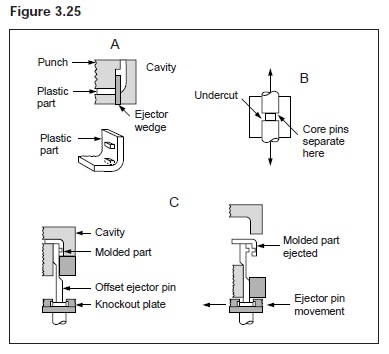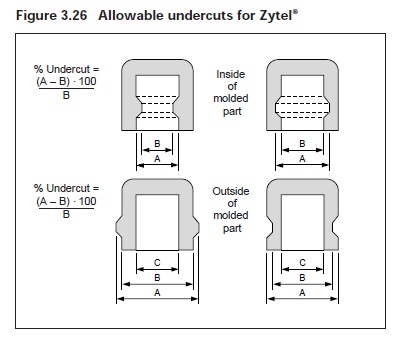Undercuts are formed by using split cavity molds or
collapsible cores.
Internal undercuts can be molded by using two
separate core pins, as shown in Figure 3.25 B. This is
a very practical method, but flash must be controlled
where the two core pins meet.
Figure 3.25 A shows another method using access to
the undercut through an adjoining wall.
Offset pins may be used for internal side wall undercuts
or holes (see Figure 3.25 C).
The above methods eliminate the need for stripping
and the concomitant limitation on the depth of the
undercut.
Undercuts can also be formed by stripping the part
from the mold. The mold must be designed to permit
the necessary deflection of the part when it is stripped
from the undercut.
Guidelines for stripped undercuts for specific resins
are:
• Delrin® acetal resin—It is possible to strip the parts
from the cavities if undercuts are less than 5% of the
diameter and are beveled. Usually only a circular
shape is suitable for undercut holes. Other shapes,
like rectangles, have high stress concentrations in
the corners which prevent successful stripping. A
collapsible core or other methods described previously
should be used to obtain a satisfactory part for
undercuts greater than 5%.
13
• Zytel® nylon resin—Parts of Zytel® with a 6–10%
undercut usually can be stripped from a mold. To
calculate the allowable undercut see Figure 3.26.
The allowable undercut will vary with thickness and
diameter. The undercut should be beveled to ease
the removal from the mold and to prevent overstressing
of the part.
• Reinforced resins—While a collapsible core or
split cavity undercut is recommended for glassreinforced
resins to minimize high stress conditions,
carefully designed undercuts may be stripped. The
undercut should be rounded and limited to 1% if
stripping from a 38°C (100°F) mold; or 2% from a
93°C (200°F) mold.

